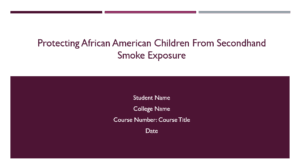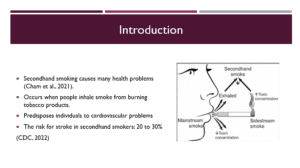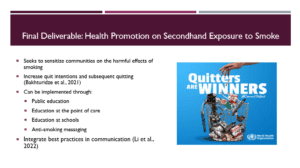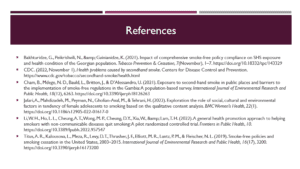Protecting African American Children From Secondhand Smoke Exposure
Hello, and welcome to this kickoff presentation. This presentation will pay particular attention to the ways of Protecting African American Children from Secondhand Smoke Exposure in Their Homes and Schools as an Avenue to Address Associated Health Inequities. Are you interested in obtaining help on your assignment ? Reach out to us.
Secondhand smoke exposure remains a common health problem. It occurs when people inhale smoke breathed out by smokers or smoke from burning tobacco products. These include cigarettes, hookahs, pipes, cigars, and other tobacco products. Secondhand smoke exposure has been attributable to many health problems. Cham et al. (2021) note that secondhand smoke exposure is just as harmful as active smoking and may predispose individuals to cardiovascular problems such as stroke and heart disease. The risk for stroke in secondhand smokers is between 20 to 30%. People living in multi-unit housing and those working in bars, casinos, and other areas where smoking is allowed are highly predisposed to secondhand smoke. Thus, measures must be taken to cushion these individuals from secondhand smoke exposure. This internship seeks to explore measures to protect African American children from secondhand smoke exposure in their homes and schools as an avenue to address associated health inequities.

Several sociocultural variables contribute to the traditional healthcare inequities affecting ethnic minority groups and have a bearing on the diseases they suffer from. Overcrowding in households due to low income, poor access to healthcare and healthcare resources due to contrary beliefs and poverty, and low literacy levels are factors that may compound suffering associated with exposure to smoke among African Americans (Jafari et al., 2022). Household overcrowding predisposes children to smoke. This is especially true when a member of the family smokes. Low literacy levels may affect how African Americans adopt recommendations on smoking prevention as well as their awareness of the harmful effects of smoking. This internship will seek to explore the accuracy of these findings among ethnic minority groups in Texas. It will evaluate the effects of Texan smoking policies on protecting against secondhand smoke and the sociocultural variables contributing to health disparities among African Americans.
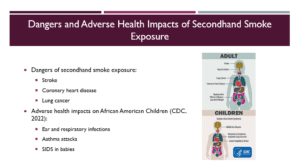
The culmination of the applied practice experience will be marked with a Zoom presentation on the adverse health impacts of secondhand smoke exposure on children, especially African-American children. This will be a demonstration of my understanding of how secondhand exposure compounds traditional healthcare problems among ethnic minority groups and how sociocultural factors influence the behavior of African Americans interplay in their diseases and suffering. Detailed, signed, and verified documentation of the internship hours will also be availed at the end of the internship. I will also submit a well-written document summarizing my experience working with the Tobacco Prevention and Control Program in Texas and the valuable knowledge I obtained that can be used to address secondhand smoke exposure.
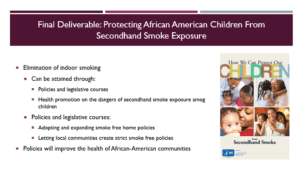
Health promotion on smoking cessation among African Americans seeks to sensitize communities to the harmful effects of smoking. Increased health promotion in these communities about the detrimental effects of tobacco can result in higher awareness and knowledge of the harmful effects of tobacco. This can, in turn, increase quitting intentions and cessation (Bakhturidze et al., 2021). This can be implemented through public education, education and point of care, and education at schools. Anti-smoking messaging at places of work can also increase quit intentions and subsequent cessation. Integral in this educative approach is tailoring the communication language to the cultural and societal needs of these individuals. Integration of best practices in communication, such as using simple language, engaging the audience, and active listening, is necessary for optimal understanding of the message passed (Li et al., 2022).
Bakhturidze, G., Peikrishvili, N., & Gvinianidze, K. (2021). Impact of comprehensive smoke-free policy compliance on SHS exposure and health condition of the Georgian population. Tobacco Prevention & Cessation, 7(November), 1–7. https://doi.org/10.18332/tpc/143329
CDC. (2022, November 1). Health problems caused by secondhand smoke. Centers for Disease Control and Prevention. https://www.cdc.gov/tobacco/secondhand-smoke/health.html
Cham, B., Mdege, N. D., Bauld, L., Britton, J., & D’Alessandro, U. (2021). Exposure to second-hand smoke in public places and barriers to the implementation of smoke-free regulations in the Gambia: A population-based survey. International Journal of Environmental Research and Public Health, 18(12), 6263. https://doi.org/10.3390/ijerph18126263
Jafari, A., Mahdizadeh, M., Peyman, N., Gholian-Aval, M., & Tehrani, H. (2022). Exploration the role of social, cultural and environmental factors in tendency of female adolescents to smoking based on the qualitative content analysis. BMC Women’s Health, 22(1). https://doi.org/10.1186/s12905-022-01617-0
Li, W. H., Ho, L. L., Cheung, A. T., Wong, M. P., Cheung, D. Y., Xia, W., & Lam, T. H. (2022). A general health promotion approach to helping smokers with non-communicable diseases quit smoking: A pilot randomized controlled trial. Frontiers in Public Health, 10. https://doi.org/10.3389/fpubh.2022.957547
Titus, A. R., Kalousova, L., Meza, R., Levy, D. T., Thrasher, J. F., Elliott, M. R., Lantz, P. M., & Fleischer, N. L. (2019). Smoke-free policies and smoking cessation in the United States, 2003–2015. International Journal of Environmental Research and Public Health, 16(17), 3200. https://doi.org/10.3390/ijerph16173200
ORDER A PLAGIARISM-FREE PAPER HERE
We’ll write everything from scratch
Question

Protecting African American Children From Secondhand Smoke Exposure
Protecting African American Children from Secondhand Smoke Exposure in Their Home and Schools as an avenue to address associated health inequities.
Description of Internship Activities to accomplish goals, student learning outcomes and final product to be delivered to the preceptor.
Title of Internship Experience:
Protecting African American Children from Secondhand Smoke Exposure in Their Home and Schools as an avenue to address associated health inequities.
Learning Outcomes/ Applied Practice Experience Activities (150 contact hours):
Develop effective professional behavior, communication, and leadership skills for careers in health
Demonstrate competence in health information
Identify the socio-economic, behavioral, biological, environmental, and other factors that impact human health and contribution to health disparities.
Overview of Plan/Overarching Goal(s) of the Applied Practice Experience:
Ms. Donald will work with CaDeidra to strengthen capacity to advocate for stronger local and regional tobacco prevention-related policies, personal where people live.
Competencies Addressed:
(Foundational Competencies)
Evaluate policies for their impact on public health and health
(Concentration Specific Competencies1. Critically examine the role of social and cultural variables contributing to health disparities.
Demonstrate an ability to work effectively with diverse communities and professions to define and address important public health concerns, such as exposure to secondhand smoke
Demonstrate increase in knowledge and skills gained during the internship by developing an educational secondhand smoke in the home flyer that the student will present during the final presentation, on the dangers of secondhand smoke
Please reference the attached description of activities. Also use CDC website and any other national resources about second hand smoke heavily for references. Please use in text citations. Reference all form of secondhand smoke cigarettes, hookah, cigars, vapes, etc.
add details from https://www.dshs.texas.gov/tobacco
Tobacco Prevention and Control Program and what Texas offer to help quit smoking towards the end of the presentation.
https://www.tarrantcountytx.gov/en/public-health/family-health-services/chronic-disease-prevention/tobacco/freedom-from-smoking.html – another program to help quit smoking elaborate on it
Add graphics to the presentation as well (professional)

